catalogue ‘Brygida Wróbel-Kulik — Illebiland’

year of publication: 2009
size: 23 × 29 cm
volume: 96 pages
edition: 500 pieces
binding: softcover
reproductions in colour
languages: Polish/German
graphic design and typesetting: Katarzyna Goczoł, Magdalena Piwkowska
publisher: BWA Contemporary Art Gallery in Katowice
ISBN 978-83-88254-53-6
Contents:
Roman Lewandowski “Beyond the matrix of the (in)visible world there’s only silence”
prof. Tadeusz Sławek “The blank face of things I”
Brygida Wróbel-Kulik “The Garden”
dr Marianne Hannen “Picture-maps in the work of Brygida Wróbel-Kulik”
Brygida Wróbel-Kulik “…”
prof. Bettina Gruber “Globalotopia”
Biography
Selected solo exibitions
Selected group exibitions
Distinctions and awards
In the media
Price: 5 zł (about 1,5 euro)
Visit our bookshop or order by e-mail:
ksiegarnia@bwa.katowice.pl

Brygida Wróbel-Kulik — Illebiland — graphics, drawings, paintings… The artist was born in 1952 in Poland. In the years 1973-1978 she studied at the Academy of Fine Arts in Cracow under the direction of Prof. Mieczysław Wejman....

“The issues relating to the interpretation and portrayal of space, along with its relationship to the visual arts, date back to prehistoric times. After all, the production of human mental activity mainly focuses on taming, appropriating or embellishing. This concerns — needless to say — a diverse range of territories, including ones of both material and mental provenance. It is worth noting that numerous archaeological finds, which date from a dozen, or a couple of dozen, thousand years ago, come in the shapes of circles or mandalas. These were often accompanied by props, whose origin was human, for example, skulls, or animal, for example, bones and horns. Sometimes, they were provided with various symbolic signs, such as crosses. These motifs were actually the first human figments of imagination. Later on, circles and mandalas, which were originally made in an abstract and minimalist way, developed into bigger narrations, acquiring a certain architectural dimension. Consequently, these figures assumed a more individual and personalized character, yet at the same time their widespread presence has made them standardised and universal communication models. Culture abounds in similar solutions, and such motifs and narrations are exemplified in the stories of Eden, or of the Labyrinth in Knossos.
Brygida Wróbel-Kulik has been making references to similar ideas almost since the beginning of her artistic career, alluding especially to a garden as a representative picture of the world. In fact, this was the title of an article she wrote as early as 1978. Since then, as a graduate from the Academy of Fine Arts in Cracow, the artist has defined her closest and most acute problems, which she has converted into a leitmotiv, a philosophical and iconic model for her own quest. From this time on, the vast majority of her realisations have tackled this problem, becoming visualisations of the issue of space and its symbolic representation, with all their consequences, in the formal and semiotic, as well as aesthetic sense. (…)”
Roman Lewandowski
“Beyond the matrix of the (in)visible world there’s only silence”
fragment




